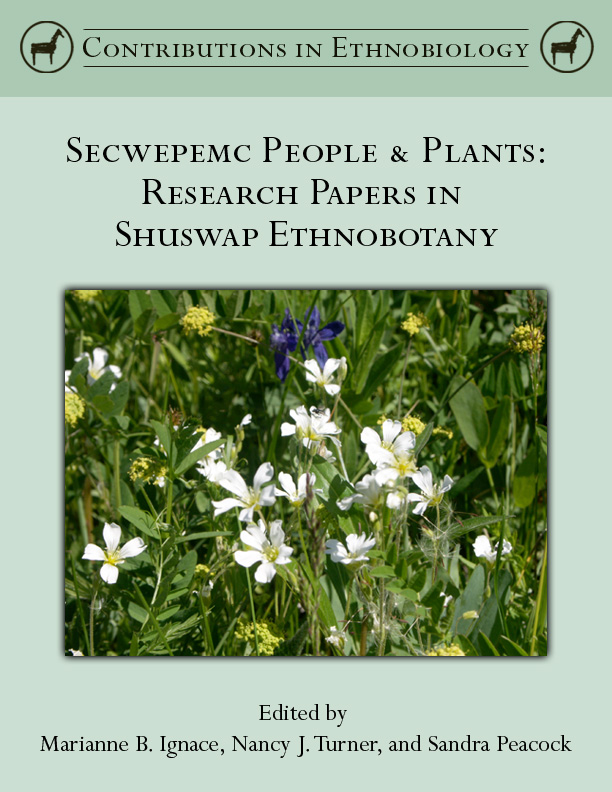Secwepemc People & Plants: Research Papers in Shuswap Ethnobotany, edited by Marianne B. Ignace, Nancy J. Turner, and Sandra Peacock

Abstract:This volume represents a culmination of collaborative research on Secwepemc (Shuswap) ethnobotany and ethno-ecology based on more than twenty years of research that has engaged Secwepemc elders, community members and a group of indigenous and non-indigenous academic researchers, supported by the Shuswap Nation Tribal Council and other local organizations in the Secwepemc Nation. The joint research and writing by knowledgeable Secwepemc elders and plant specialists, working together with academic researchers comprises multiple interdisciplinary approaches that range from ethnobotany, ethnopharmacology, nutrition, environmental science, to archaeology and linguistic anthropology. Together, they have enabled a detailed understanding of the practices and knowledge systems surrounding the past and present relationships of the Secwepemc people with the plant world as part of the wider relationship with their homeland and its life forms. This volume of specific research contributions, together with a Secwepemc Ethnobotany to be published separately, will highlight the critical importance of plants and environments for Secwepemc health, well-being and cultural identity. Moreover, this work can serve as a model for other interdisciplinary collaborative community based research projects, and we are proud to be able to present our findings through this new Society of Ethnobiology venue.
Contents
- Chapter 1. INTRODUCTION
Nancy J. Turner and Marianne B. Ignace - Chapter 2. RE TSUWET.S-KUCW NE SECWÉPEMCÚL’CW – SECWEPEMC RESOURCE USE AND SENSE OF LANDSCAPE
Ron Ignace and Marianne B. Ignace - Chapter 3. LONG-TERM SECWEPEMC PLANT USE: INITIAL RESULTS OF ARCHAEOBOTANICAL INVESTIGATIONS IN THE INTERIOR PLATEAU
George P. Nicholas and Leisl Westfall - Chapter 4. LINKING THE ETHNOBOTANY AND THE ARCHAEOLOGY: ANCIENT PLANT REMAINS FROM SITE EERB 140, KAMLOOPS
Michele Wollstonecroft - Chapter 5. Re Secwepemc re Syucwmenúl’ecwems: Secwepemc Stewardship of Lands and Resources
Sandra Peacock, Nancy J. Turner and Marianne B. Ignace - Chapter 6. NUTRIENTS IN SELECTED SECWEPEMC TRADITIONAL FOOD SPECIES
Harriet V. Kuhnlein, Dawn Loewen, Sandra Peacock, Donna Leggee and Nancy J. Turner - Chapter 7. YELLOW GLACIER LILY (ERYTHRONIUM GRANDIFLORUM): IMPORTANT ROOT VEGETABLE FOR THE SECWEPEMC AND NEIGHBOURING PEOPLES OF THE NORTHWEST INTERIOR PLATEAU
Dawn Loewen, NJ Turner and Mary Thomas - Chapter 8. WILA: ELDERS’ USE AND KNOWLEDGE OF PITCOOKING
Stuart Crawford - Chapter 9. THE IMPORTANCE OF CULTURAL KNOWLEDGE IN UNDERSTANDING THE ANTIMICROBIAL CHEMISTRY OF BALSAMROOT (BALSAMORHIZA SAGITTATA)
Kelly Bannister and Mary Thomas - Chapter 10. “EVERYTHING IS DETERIORATING”: ENVIRONMENTAL AND CULTURAL LOSS IN SECWEPEMC TERRITORY
Mary Thomas, Nancy J. Turner and Ann Garibaldi - Chapter 11. COYOTE, GROUSE AND TREES: SECWEPEMC LESSONS ABOUT ETHNOBIOLOGICAL KNOWLEDGE
Marianne B. Ignace and Nancy J. Turner - Chapter 12. TRADITIONAL ECOLOGICAL KNOWLEDGE AND WISDOM OF THE SECWEPEMC PEOPLE
M. Ignace, R. Ignace & N. Turner - Chapter 13. CONCLUSIONS
Nancy Turner, Marianne B. Ignace, and Ron Ignace
